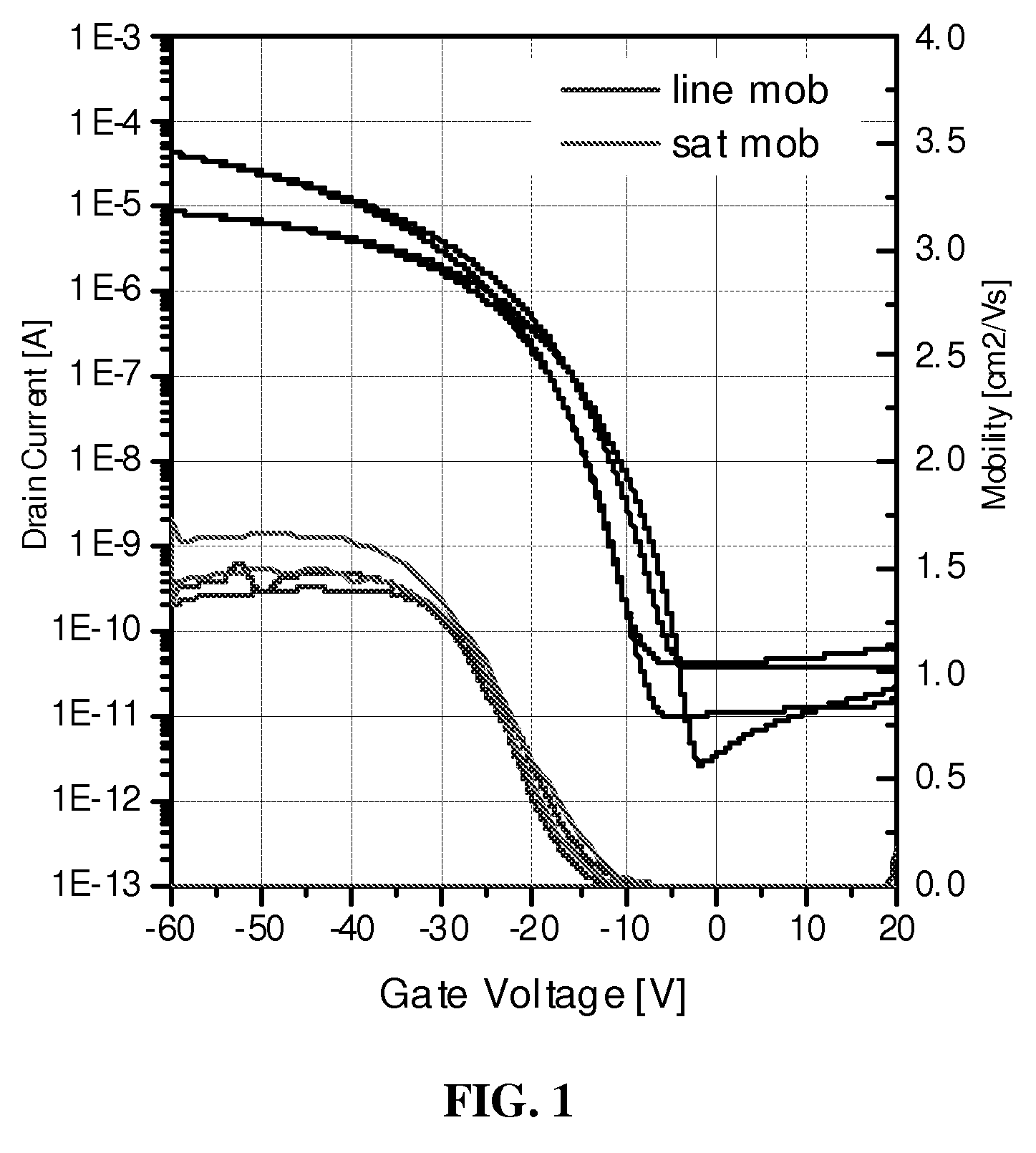Non-linear acene derivatives and their use as organic semiconductors
a technology of organic semiconductors and acene derivatives, applied in the direction of organic chemistry, non-metal conductors, conductors, etc., can solve the problems of reducing device performance, unsuitable for the fabrication of large-area films, and high processing costs, and achieve the goal of reducing the number of backplane-driving transistors. the effect of reducing the number of transistors
- Summary
- Abstract
- Description
- Claims
- Application Information
AI Technical Summary
Benefits of technology
Problems solved by technology
Method used
Image
Examples
example 1
1.1. Dibenzo[a,h]anthracene-7,14-dione
[0222]
[0223]To 1,4-benzoquinone (110 g, 1020 mmol) and vinyl-benzene (233 cm3, 2040 mmol) is added 1-butanol (300 cm3) and the mixture heated at reflux for 17 hours. The mixture is allowed to cool and the solvent removed in vacuo. The residue is purified by silica plug (dichloromethane) and then recrystallised twice from acetonitrile to give dibenzo[a,h]anthracene-7,14-dione as an orange solid (5.0 g, 1.6%). 1H NMR (300 MHz, CDCl3) 7.61-7.70 (2H, m, ArH), 7.71-7.80 (2H, m, ArH), 7.91 (2H, d, ArH, J 8.1), 8.20 (2H, d, ArH, J 8.6), 8.37 (2H, d, ArH, J 8.6), 9.62 (2H, d, ArH, J 8.8); 13C NMR (300 MHz, CDCl3) 122.7, 127.9, 128.5, 128.6, 128.7, 130.0, 135.2, 135.6, 136.3, 186.9.
1.2. Dibenzo[a,h]anthracene-7,14-dione
[0224]
[0225]To a solution of naphthalene-1-carboxylic acid diethylamide (1.15 g, 5.0 mmol) in anhydrous tetrahydrofuran (20 cm3) at −78° C. is added sec-butyllithium (11.5 cm3, 15 mmol) dropwise over 30 minutes. The solution is then stirre...
example 2
7,14-Bis-[(triisopropylsilanyl)-ethynyl]-dibenzo[a,h]anthracene
[0232]
[0233]To a solution of (triisopropylsilyl)acetylene (2.7 cm3, 12 mmol) in anhydrous tetrahydrofuran (50 cm3) at 0° C. is added dropwise n-butyllithium (4.4 cm3, 11 mmol, 2.5 M in hexanes). After addition, the mixture is stirred at 0° C. for 10 minutes and then at 23° C. for 1 hour. Dibenzo[a,h]anthracene-7,14-dione (0.75 g, 2.4 mmol) is then added and the reaction mixture stirred at 23° C. for 17 hours. A saturated solution of tin(II)chloride in 10% aqueous hydrochloric acid (20 cm3) is added and the reaction mixture stirred at 50° C. for 1 hour. The mixture allowed to cool and poured into water (300 cm3) and the precipitate collected by filtration. The filtrate is extracted with dichloromethane (2×200 cm3) and the combined organic extracts dried over anhydrous magnesium sulfate, filtered and the solvent removed in vacuo. The residue is stirred in methanol (100 cm3) and the precipitate collected and combined with t...
example 3
7,14-Bis-triethylsilanylethynyl-dibenzo[a,h]anthracene
[0235]
[0236]To a solution of (triethylsilyl)acetylene (1.7 g, 12 mmol) in anhydrous tetrahydrofuran (50 cm3) at 0° C. is added dropwise n-butyllithium (4.4 cm3, 11 mmol, 2.5 M in hexanes). After addition, the mixture is stirred at 0° C. for 10 minutes and then at 23° C. for 1 hour. Dibenzo[a,h]anthracene-7,14-dione (see Example 1) (0.75 g, 2.4 mmol) is then added and the reaction mixture stirred at 23° C. for 17 hours. A saturated solution of tin (II) chloride in 10% aqueous hydrochloric acid (20 cm3) is added and the reaction mixture stirred at 40° C. for 30 minutes. Water (100 cm3) is added and the product is extracted with dichloromethane (3×200 cm3) and the combined organic extracts dried over anhydrous magnesium sulfate, filtered and the solvent removed in vacuo. The crude is purified by column chromatography (40-60 petrol with 10% dichloromethane) and then recrystallised from tetrahydrofuran / methanol to give 7,14-bis-trieth...
PUM
| Property | Measurement | Unit |
|---|---|---|
| Electric charge | aaaaa | aaaaa |
| Frequency | aaaaa | aaaaa |
| Pressure | aaaaa | aaaaa |
Abstract
Description
Claims
Application Information
 Login to View More
Login to View More - R&D
- Intellectual Property
- Life Sciences
- Materials
- Tech Scout
- Unparalleled Data Quality
- Higher Quality Content
- 60% Fewer Hallucinations
Browse by: Latest US Patents, China's latest patents, Technical Efficacy Thesaurus, Application Domain, Technology Topic, Popular Technical Reports.
© 2025 PatSnap. All rights reserved.Legal|Privacy policy|Modern Slavery Act Transparency Statement|Sitemap|About US| Contact US: help@patsnap.com



